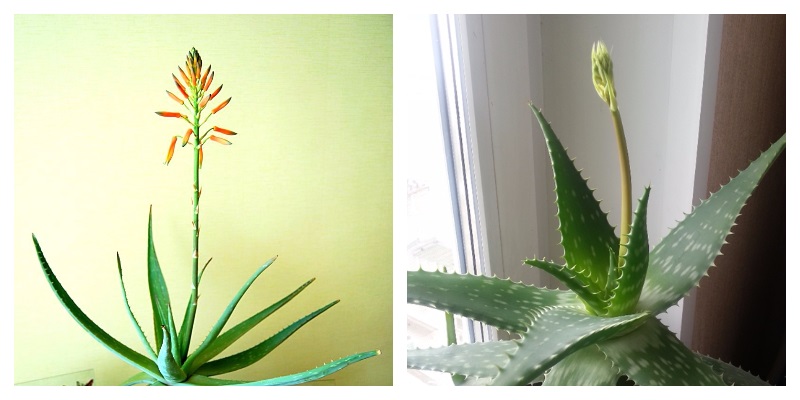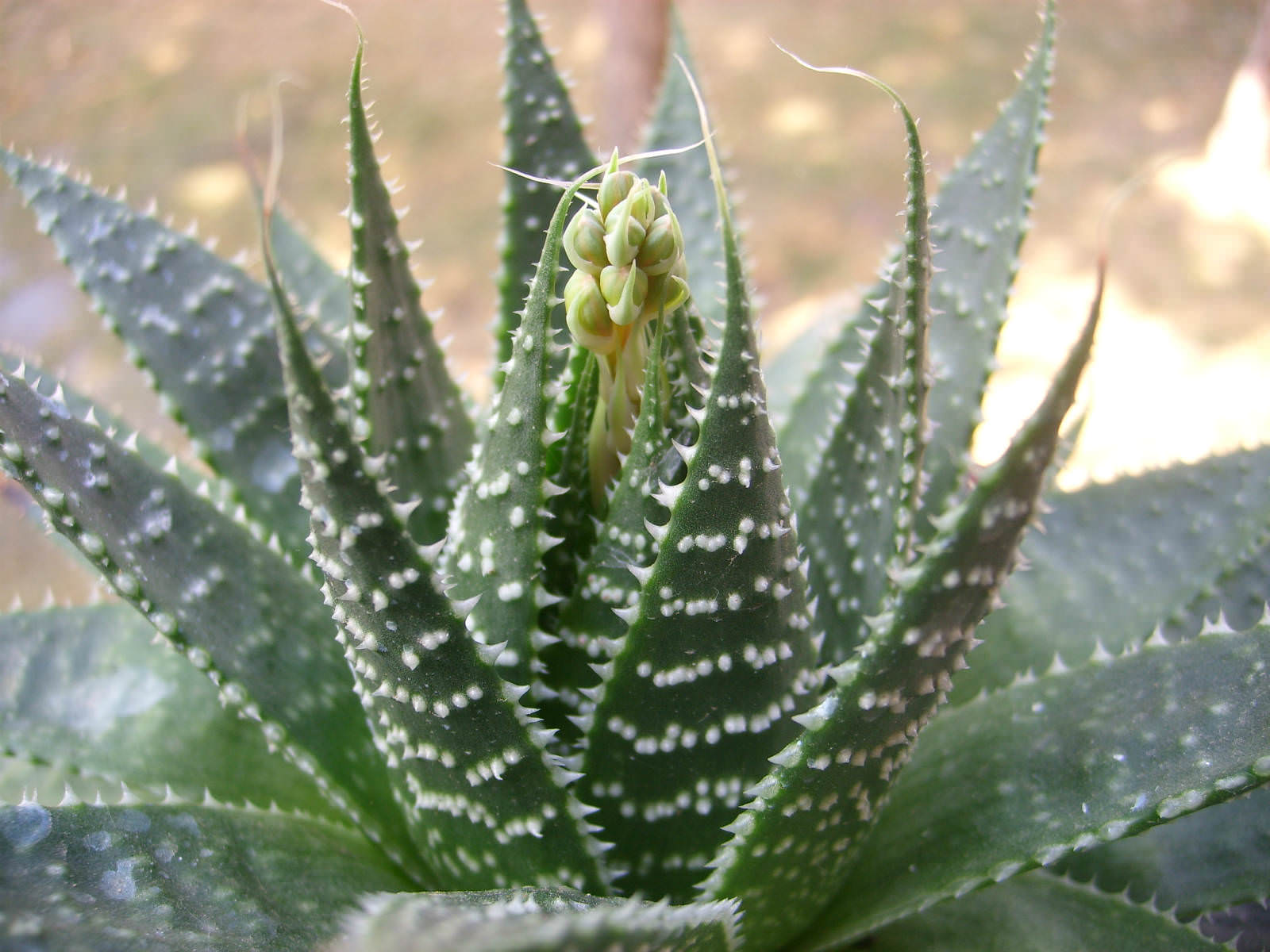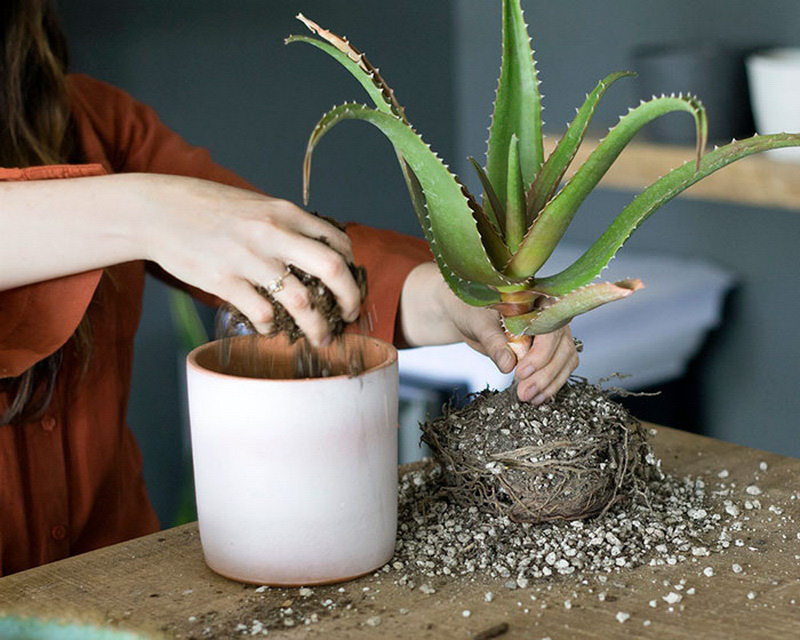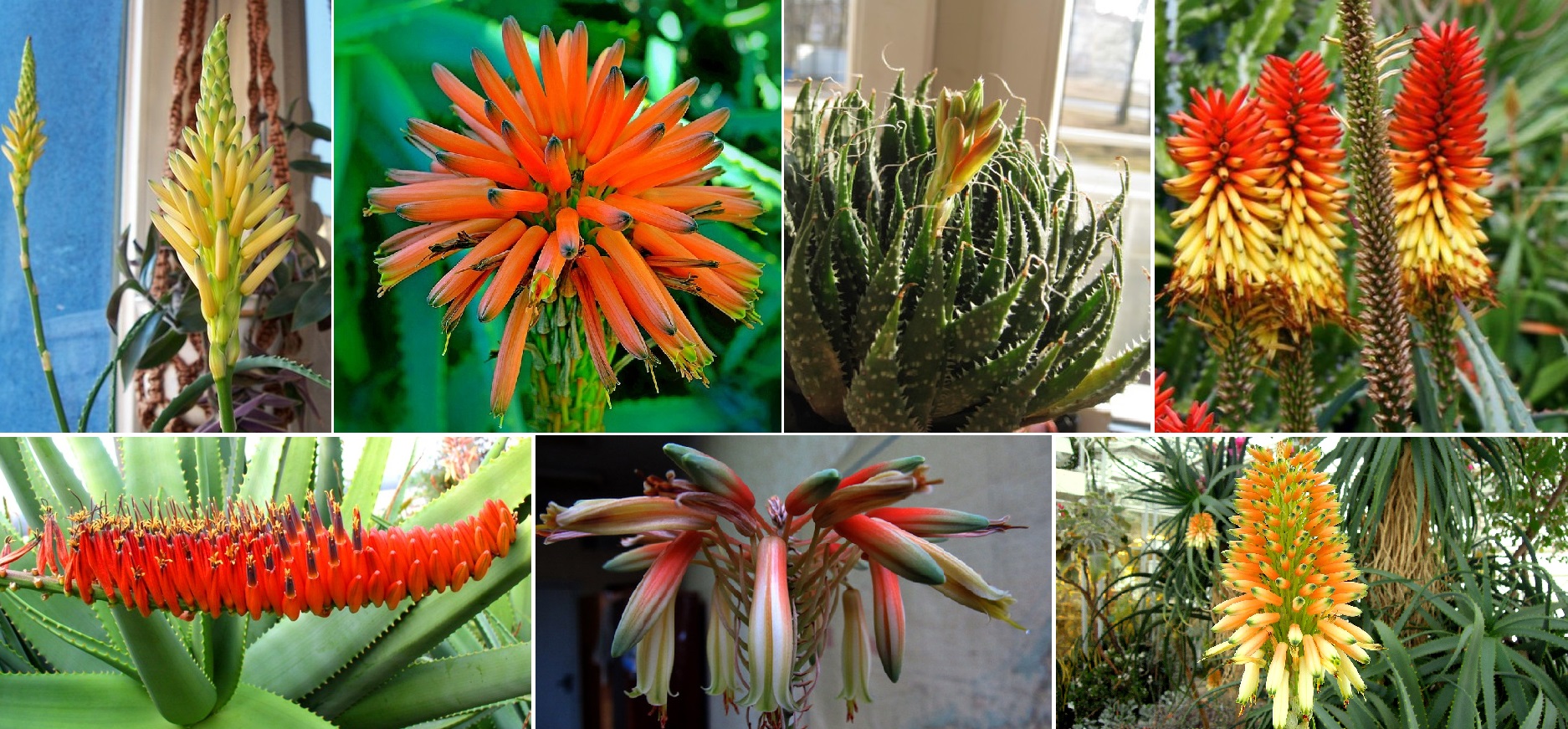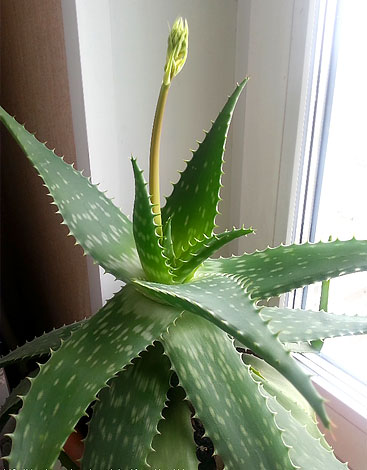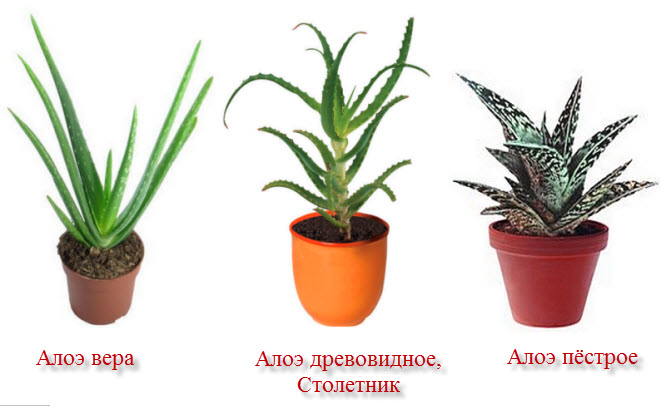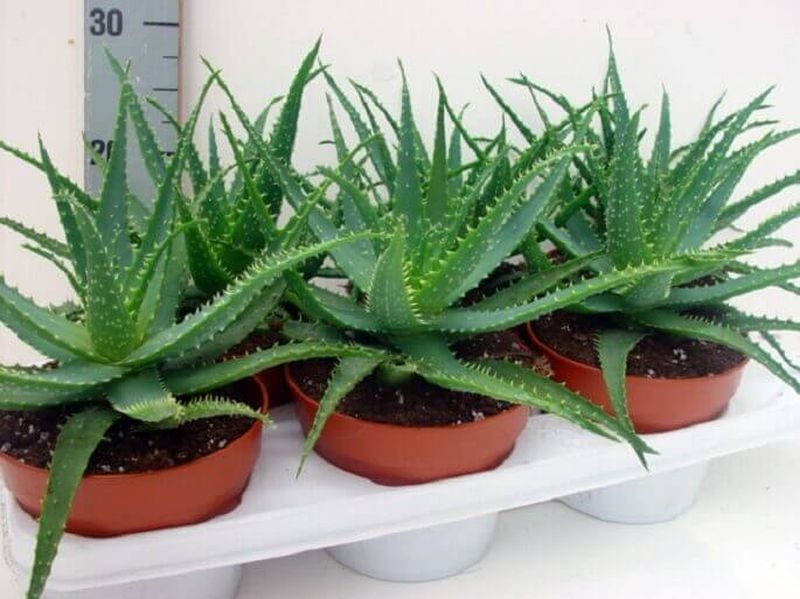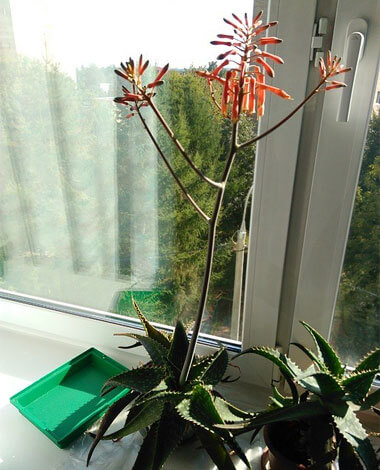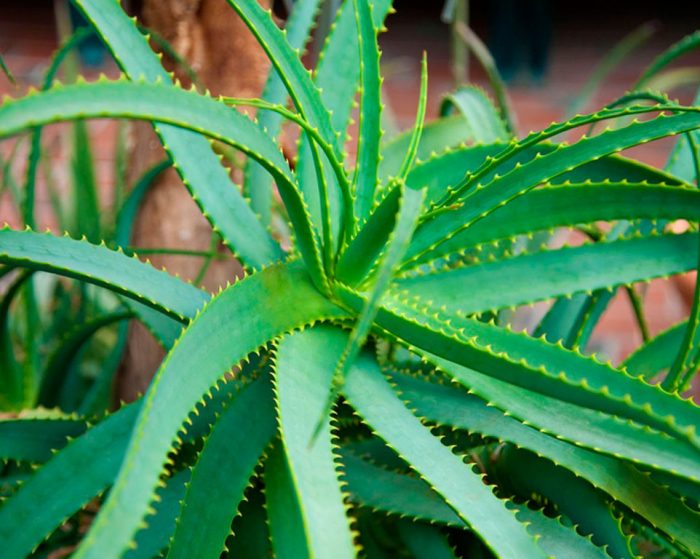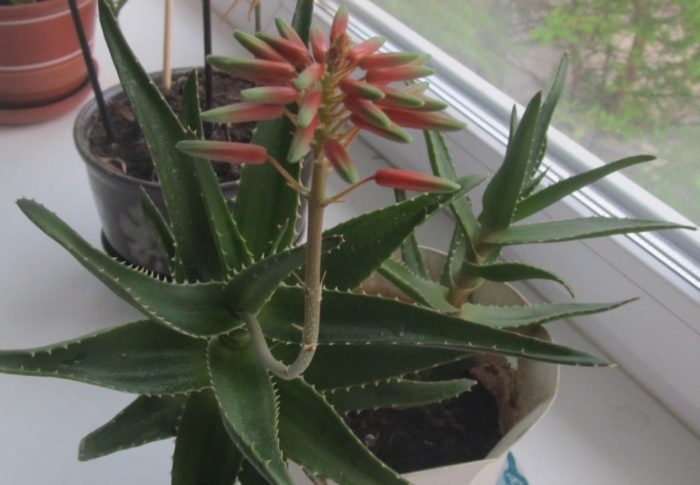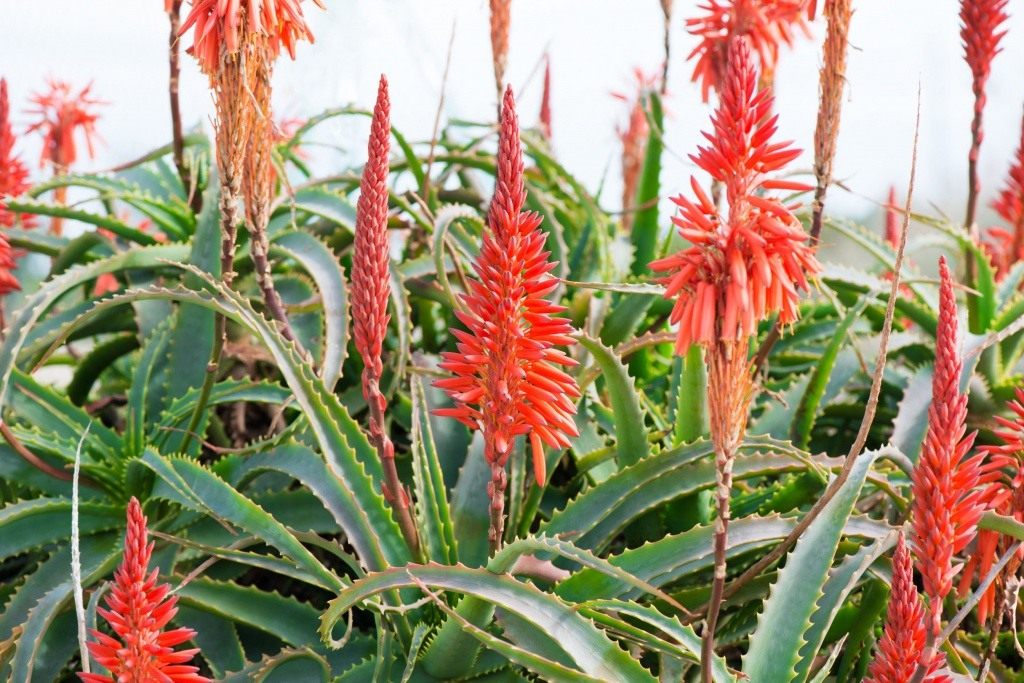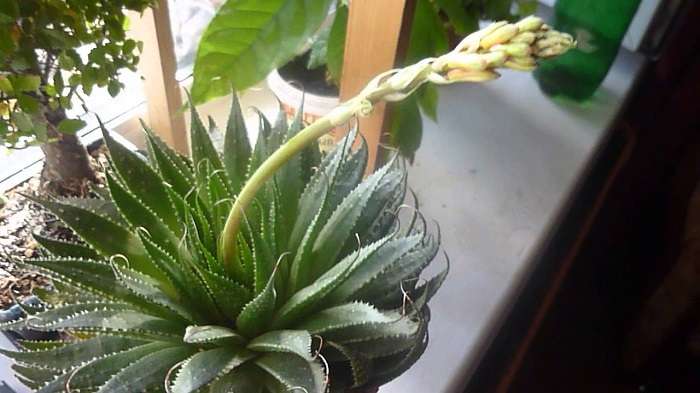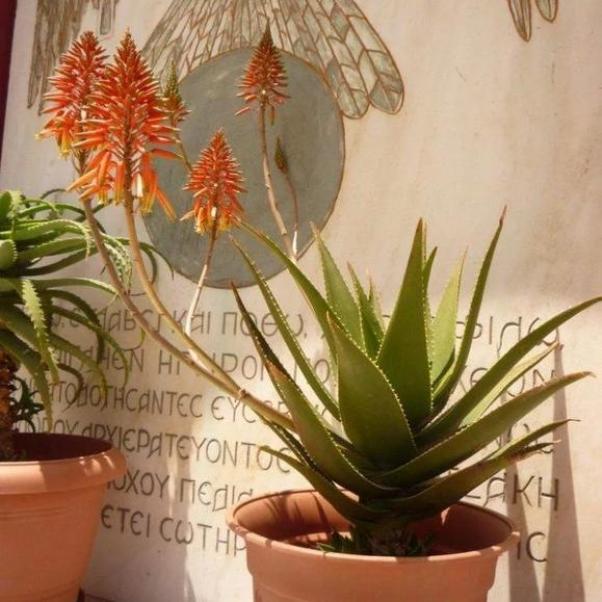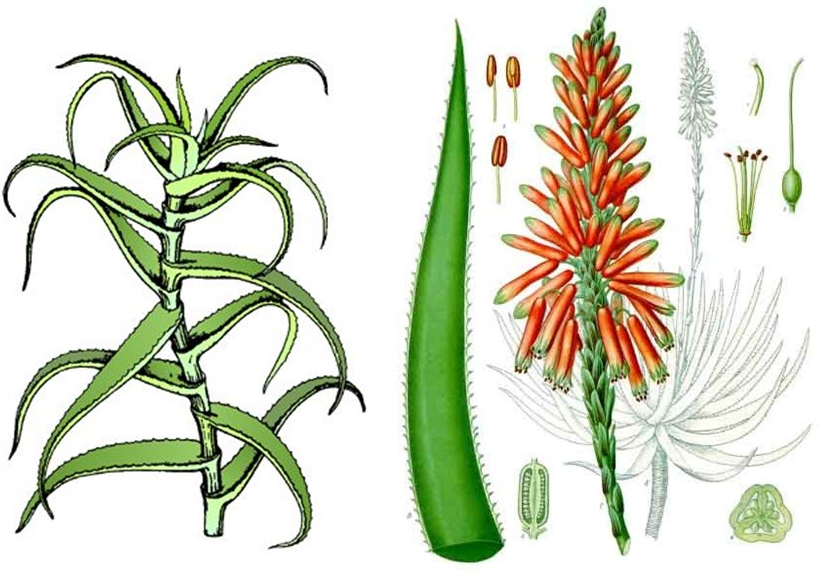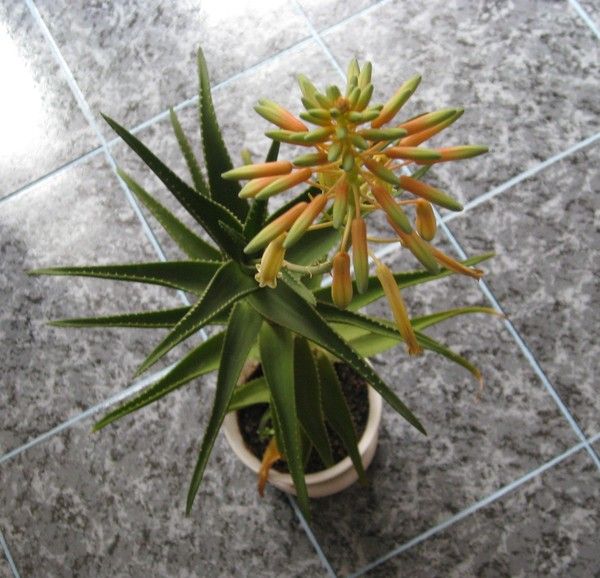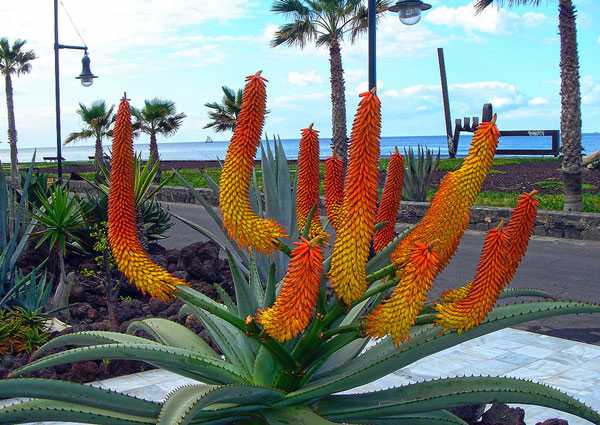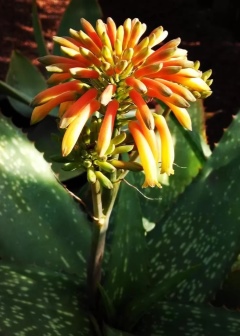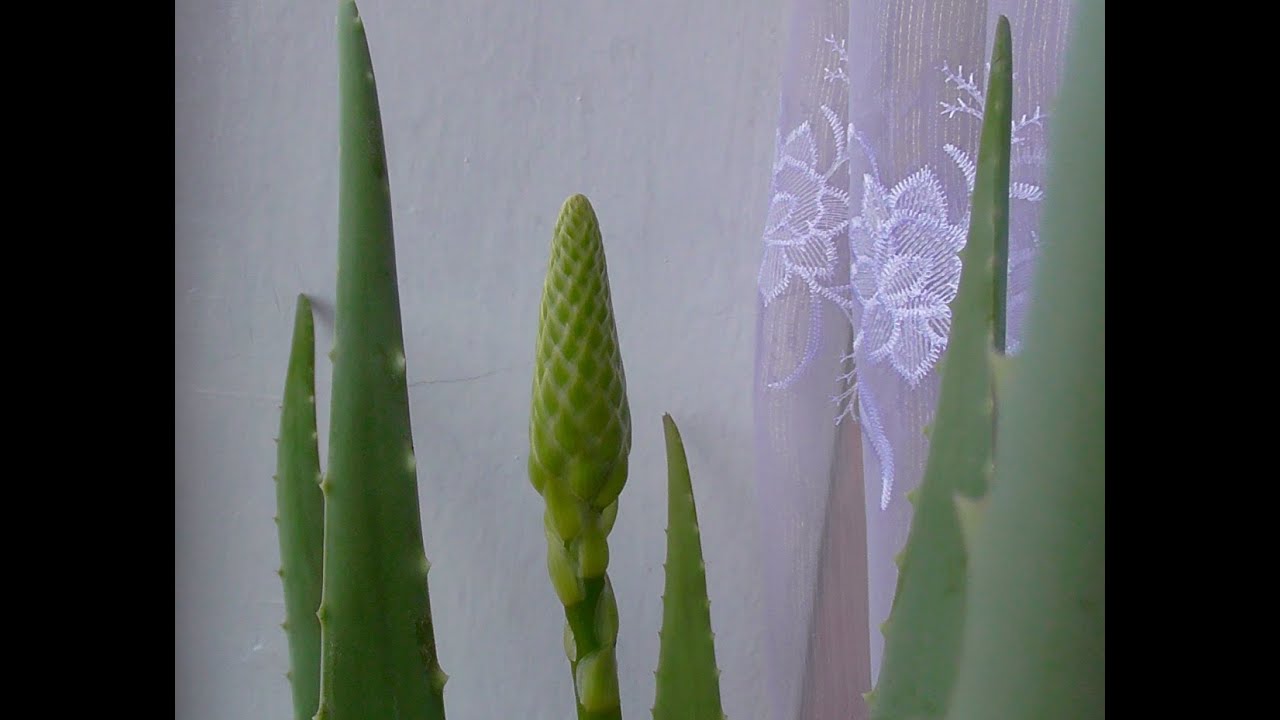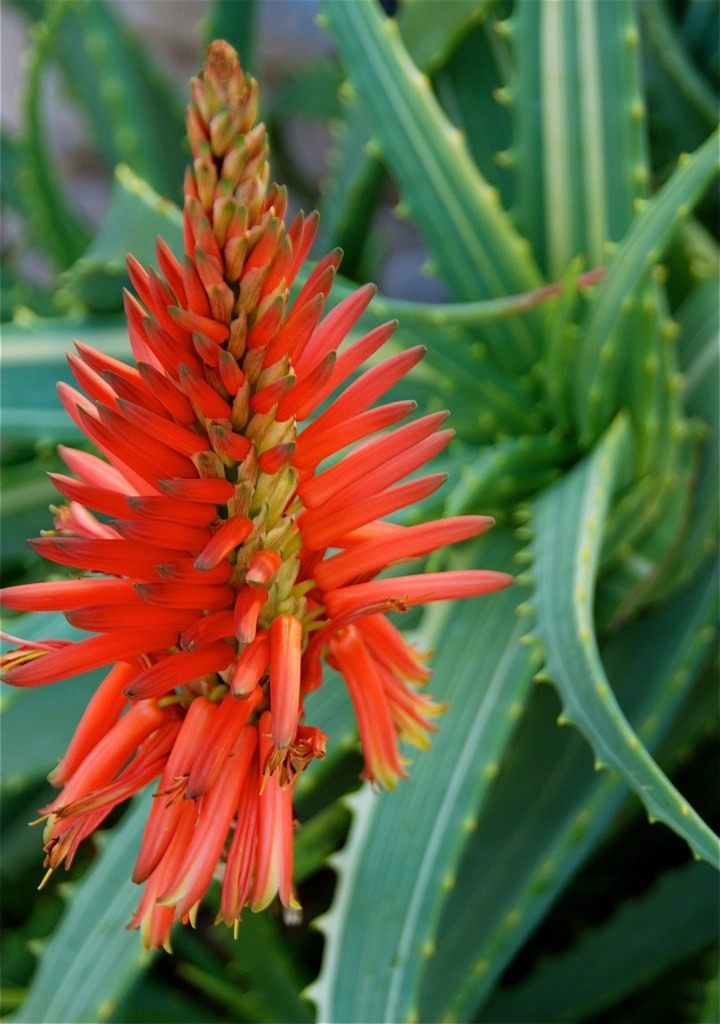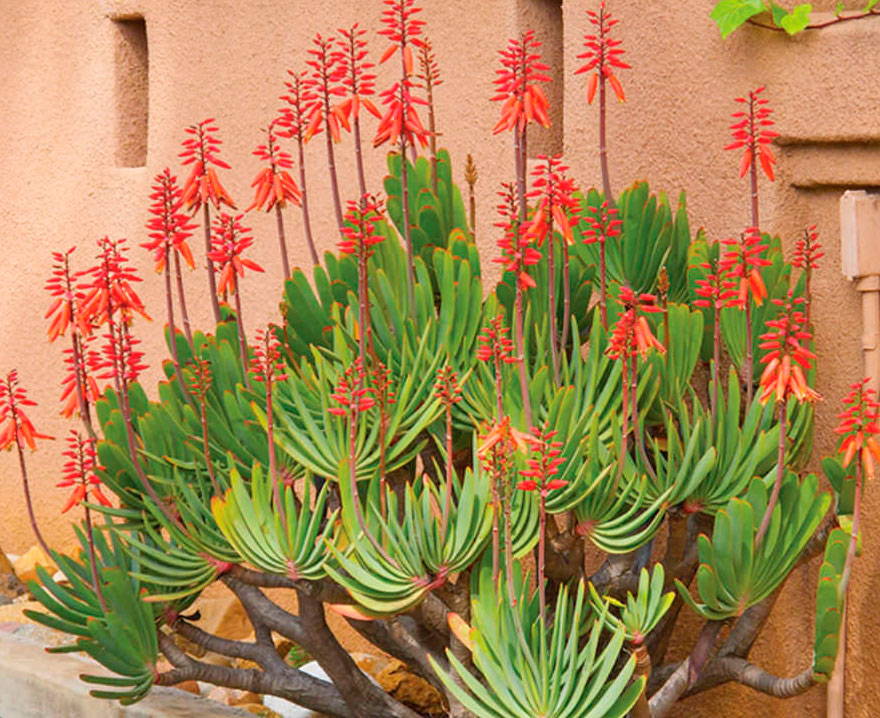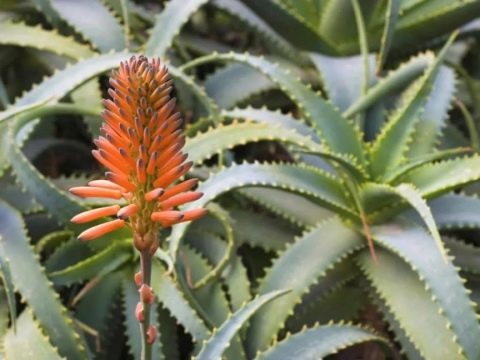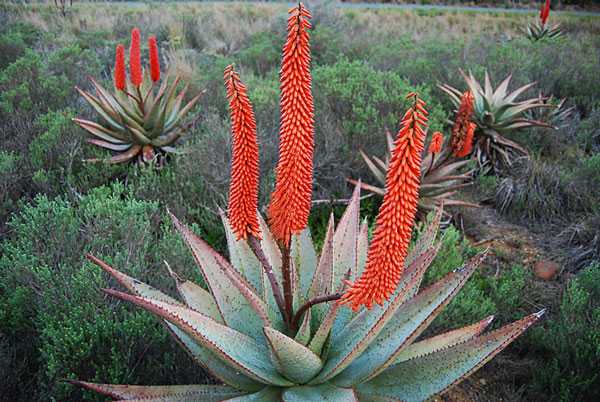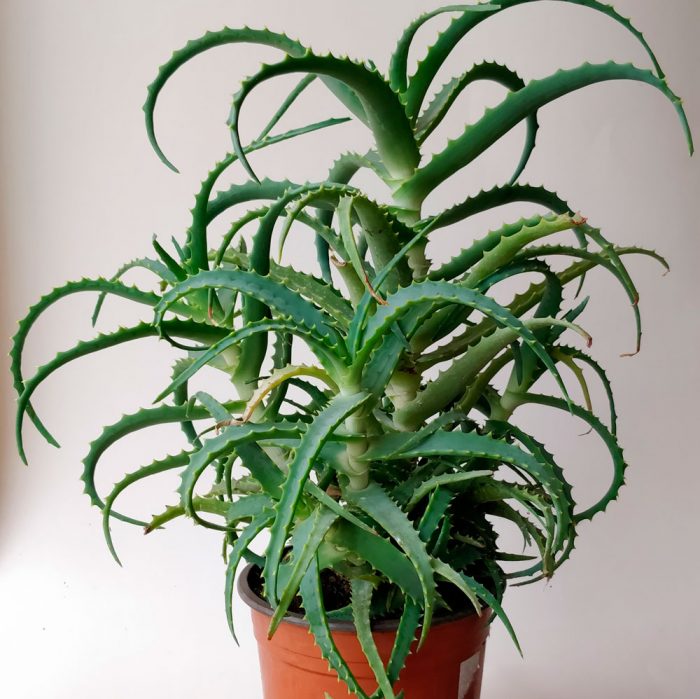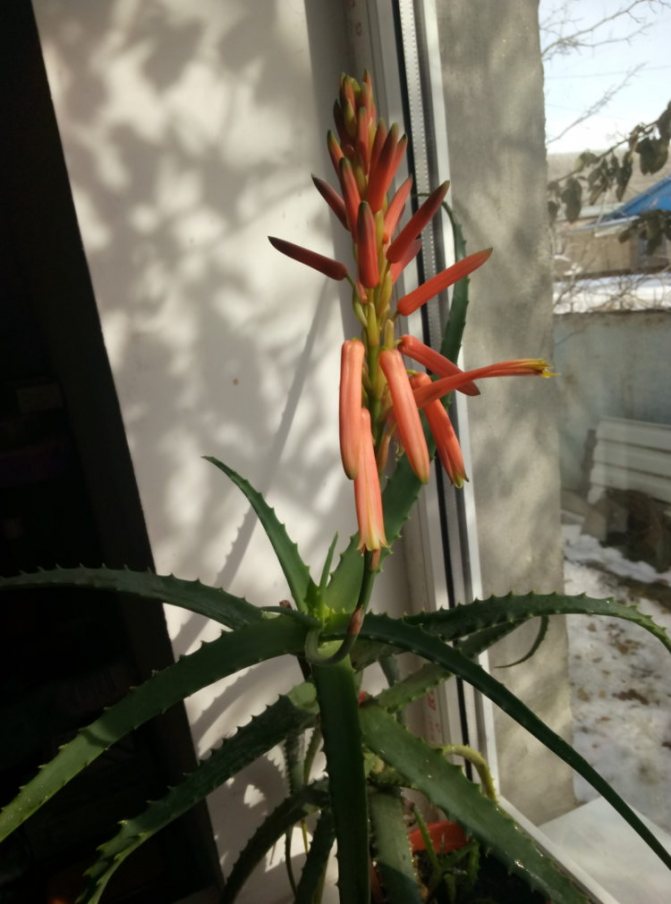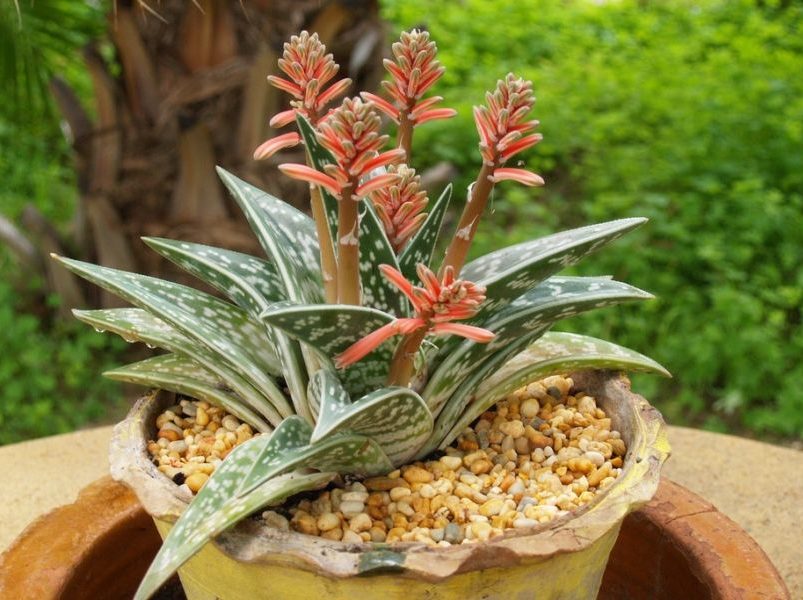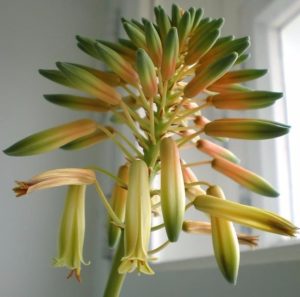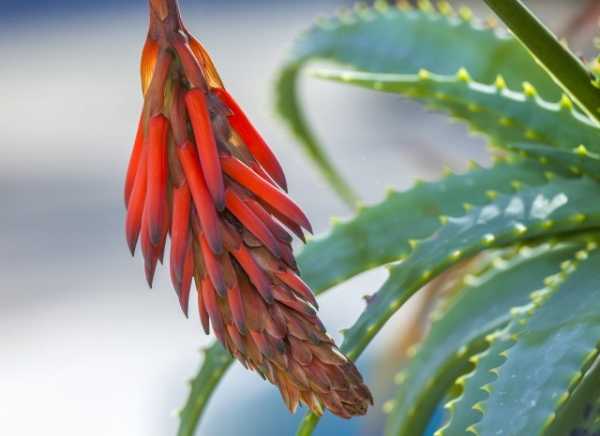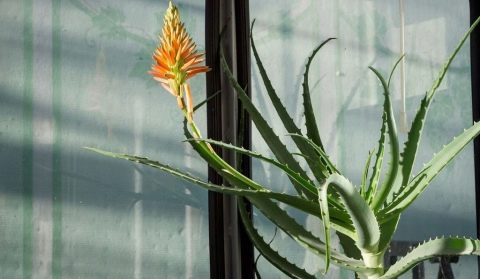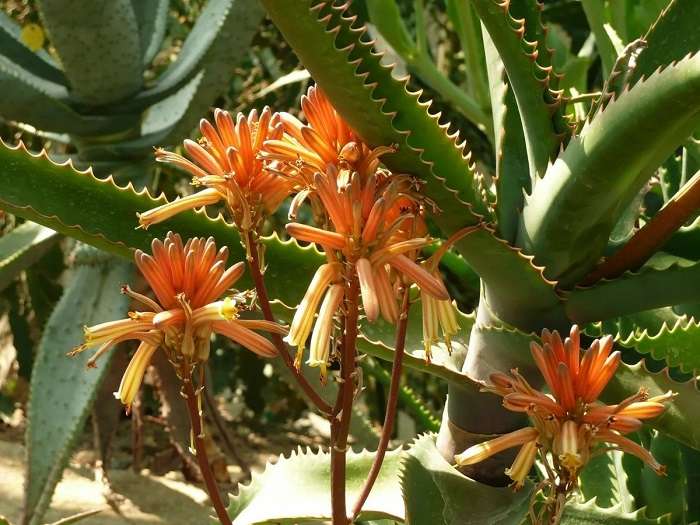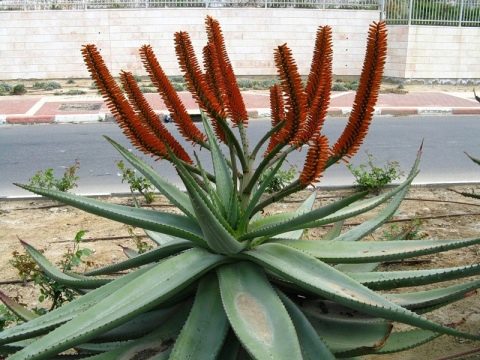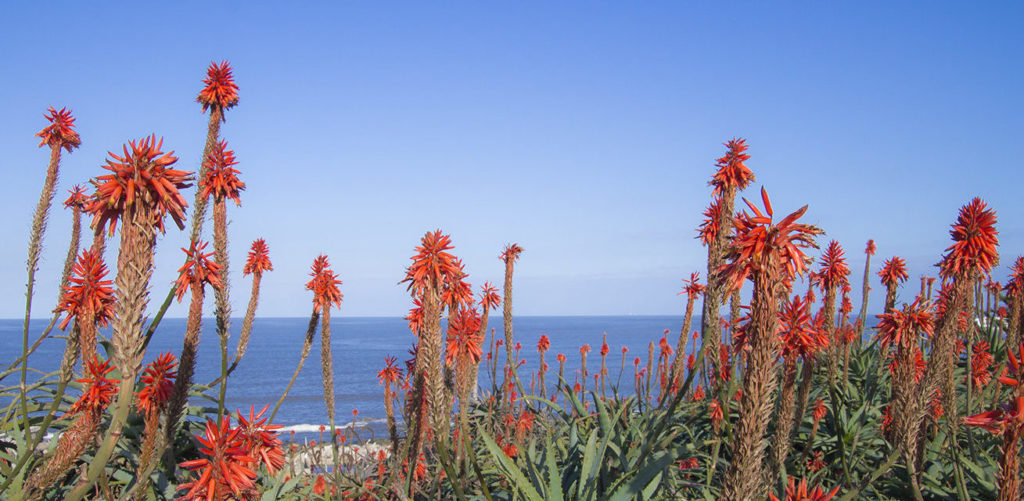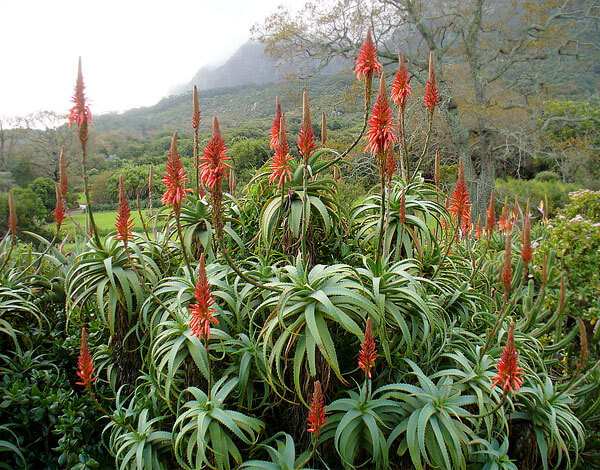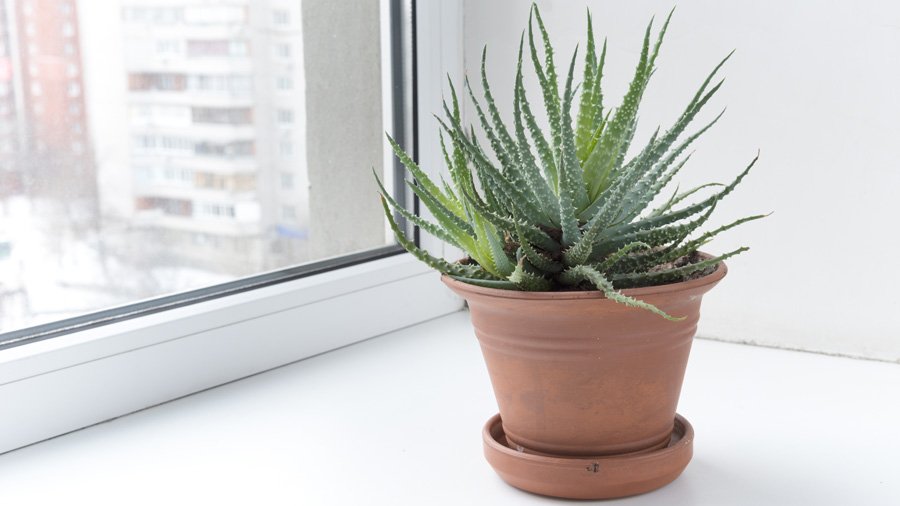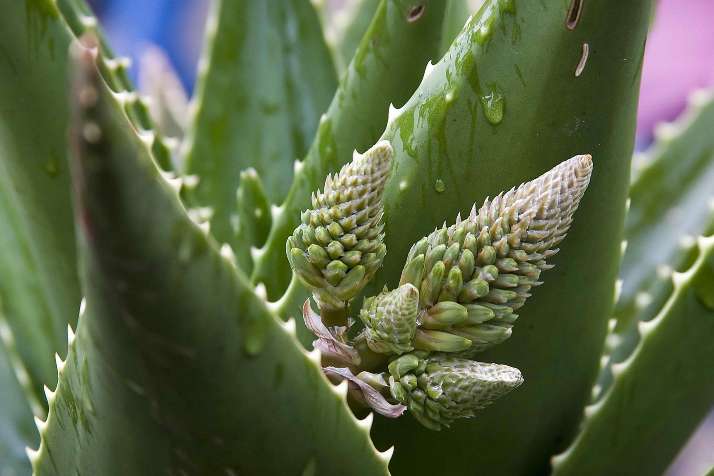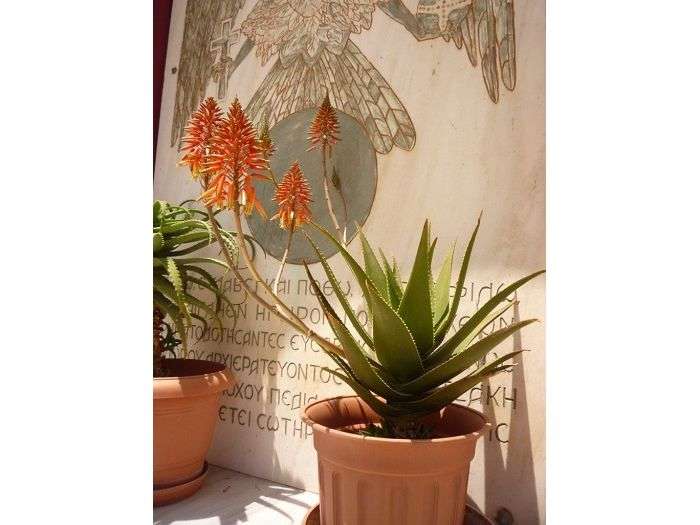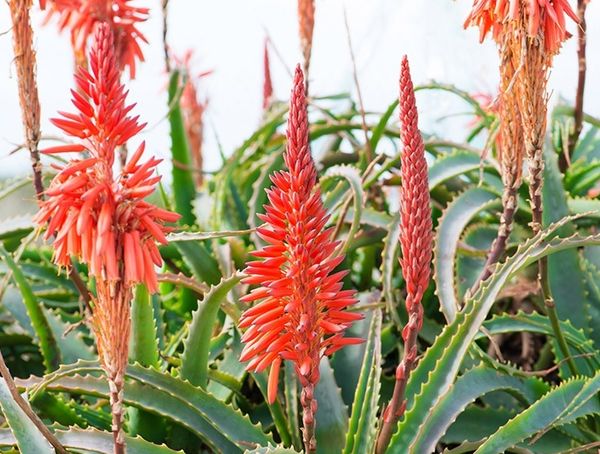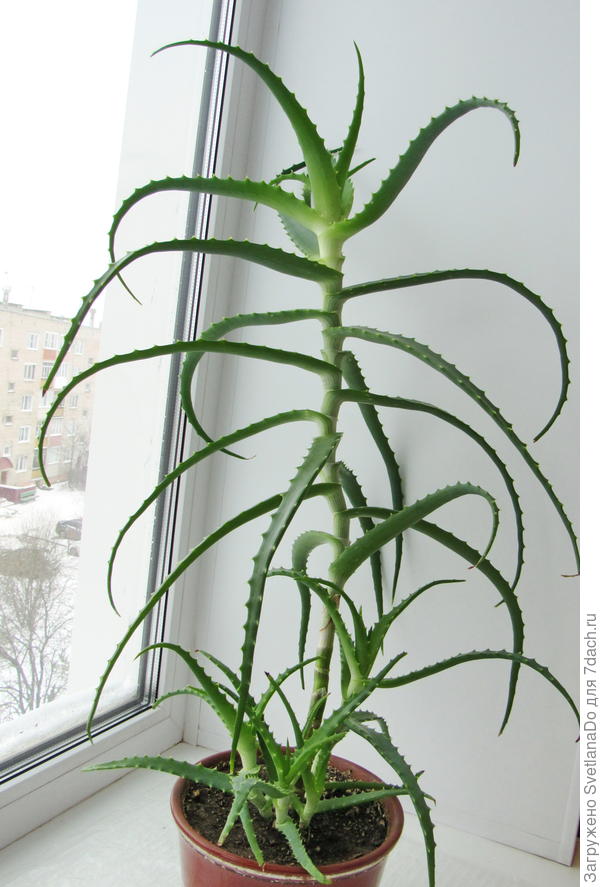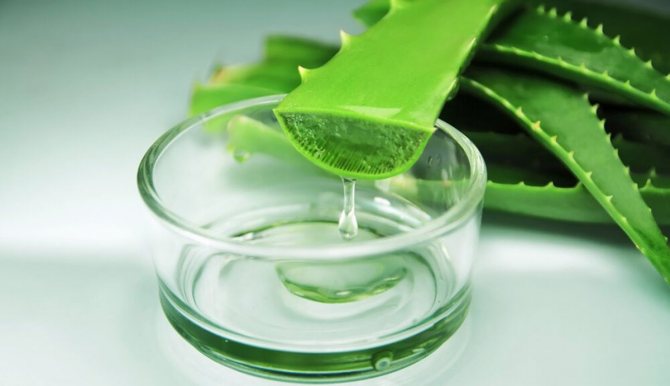Folk omens about aloe
Yes, among other things, some signs are associated with aloe. Believe in them or not is a purely personal matter, nevertheless, here they are:
- One old omen says - if an aloe has blossomed in your house, then an angel has settled in the house;
- Aloe protects the house and residents from evil eyes, damage and negative energy;
- If you hang a dried leaf of a plant over the door to the house, then bad and unwanted "guests" will no longer bother you;
- Another sign says that aloe gives its owners health and longevity;
- The plant helps to find a soul mate and start a family. To do this, you need to cut off 13 aloe leaves. Hide them and dry them for 12 days. On the 13th day, dry leaves were burned, and the ashes were thrown in front of the doorstep. It was imperative to apologize to the aloe for the pain;
- Protective amulets are made from dry roots by placing them in small bags. According to the omen, such amulets protect the owner from diseases, negativity and bad wishes.
Aloe species that bloom easily indoors
Theoretically, at home, it is quite possible to achieve flowering of any of the types of aloe grown in an apartment, and even more so in a winter garden or greenhouse. However, of all ages known in indoor cultivation, the following are most willing to bloom:
Aloe spinous (A. aristata) - the peduncle appears from the middle of the rosette, grows vertically, often branches into two or more flower-bearing pagons, at the top of each of them a brush of multiple long-tubular flowers of coral or yellow-orange color is formed, opening in turn, starting from the bottom.

Aloe spinous (A. aristata)
Aloe variegated (A. variegata) - blooms in March or April with orange tubular flowers, collected in a bunch at the top of a not too high peduncle - no more than 20-30 cm. Sometimes forms several flowering stems, single or branched, growing strictly vertically.
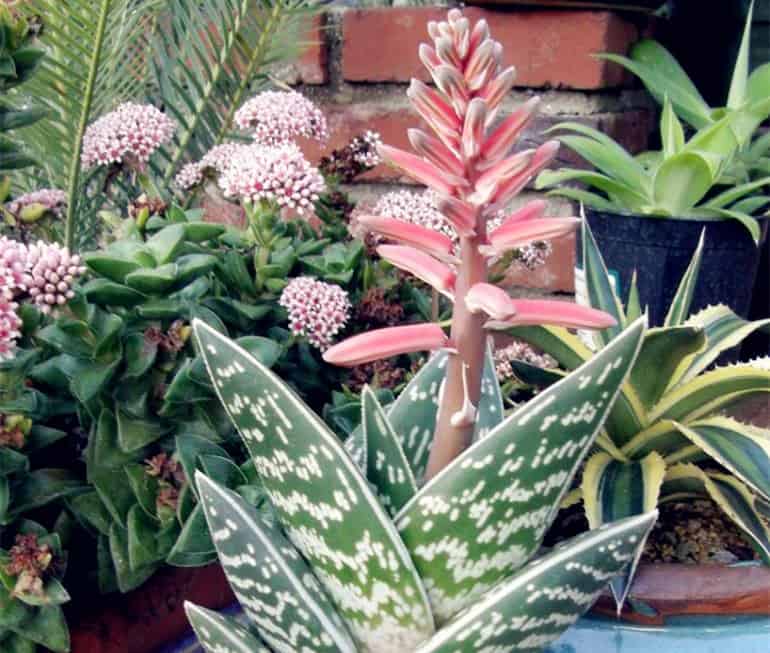
Aloe variegated (A. variegata)
Aloe squat (A. humilis) - forms a powerful peduncle 25–35 cm high with a racemose inflorescence on the crown, consisting of scarlet or orange cylindrical flowers no more than 3 cm long.

Aloe squat (A. humilis)
With some effort, it is perfectly acceptable to initiate flowering of other types of aloe:
white-flowered (albiflora);


Aloe fan (plicatilis)
faith (vera) with large bright orange inflorescences;



Aloe cap-shaped (mitriformis)
short-leaved (brevifolia) - scarlet inflorescences;
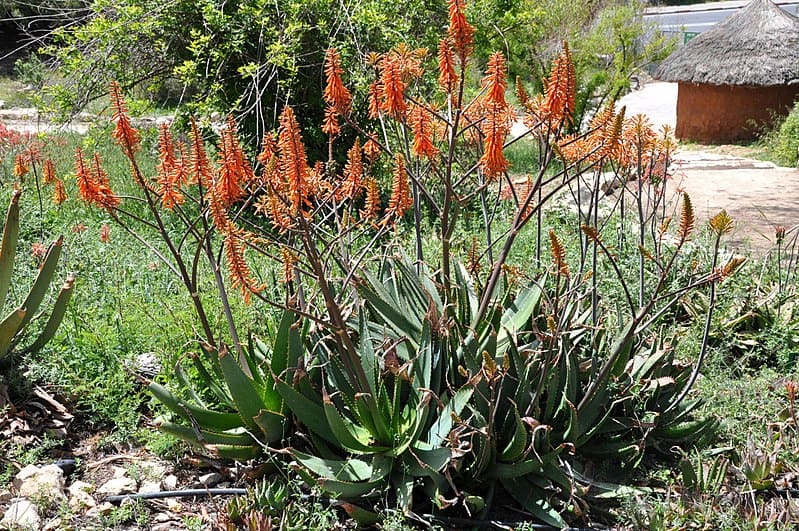

Aloe pretty (bellatula)
Especially effective in bloom is a rare type of aloe - spiral (polyphylla) with leaves twisted into a spiral. Its peduncle grows on the side of the rosette and is a real tree of 8-10 pagons, at the top of each is a fluffy tousled armful of orange-red tubular flowers drooping down.

Aloe spiral (polyphylla)
Examples of caring for a flower in a pot
Talking about how to care for aloe inpot at home, a number of tips work here. At the beginning of May and at the very end of October, before the first frost, it can be taken out into the street, caring according to the rules described above. The main thing is to understand that 80% of the flower consists of liquid, so even the first light frosts will have a detrimental effect on it.
Maintenance in winter provides for a dormant period: a minimum of watering and no feeding. At this time, it is in a state of sleep, so there is no need to disturb it once again. In the question of whether it is worth pruning aloe, there is a simple answer: if these are tree-like, tall varieties, then yes. This will stimulate the growth of side shoots and rejuvenate the plant.
It is important to know what diseases and insects harm the plant. Most often he is struck by:
- root rot. It spoils the root system, and the plant rots. The reason lies in the excess moisture. If found, it is worth replanting the plant or rooting young shoots;
- dry rot is already the opposite pathology, which arises from a lack of moisture. In this case, the plant dries up from the inside and it is almost impossible to save it;
- shield. It sucks out all the juices from the plant, and this leads to its weakening and wilting. To combat it, you can treat the plant with a vinegar solution or store-bought preparations, following the instructions;
- A spider mite is a small reddish spider that braids a plant with cobwebs. Against him, it is worth treating the plant with infusion of tobacco and soap, rinse under running water. If it is not possible to remove it in 2-3 treatments, it is worth resorting to store-bought preparations.
Note! If all these conditions of detention are observed, a handsome home and a prickly healer will always be healthy.
How to propagate indoor aloe?
In nature, aloe is propagated by seeds or root processes. Florists can use a method that is convenient for them personally.
Propagated by children (root shoots)
When babies appear at the base of the mother plant - small plants 5-10 cm high with 2-3 leaves, you can use them as planting material. There are two ways to separate those:
completely remove the mother plant, along with the roots, shoots and soil from the pot, carefully disconnect the children along with the roots and plant the plants;
carefully dig out the shoots from the pot, without transferring the adult plant and trying not to damage the roots.
This is what an adult plant looks like, which has produced shoots suitable for moving to other pots.
Rooting cuttings-leaves
Planting materials are taken from different parts of the plant, but rooted using the same technology.
Carefully break off the leaf as close to the ground as possible. It must be at least 5-10 cm high.
We place it for a day in a dark place in the apartment so that the wound dries up and heals. You can dip the tear-off site into crushed charcoal for disinfection.
Then we bury the sheet in wet sand to a depth of 1 cm
Do not spray the plant and cover with a jar or film! It is important that only sand remains wet at all times. Aloe Vera should take root in two weeks
This can be understood by the more intense green color, a new leaf will appear.
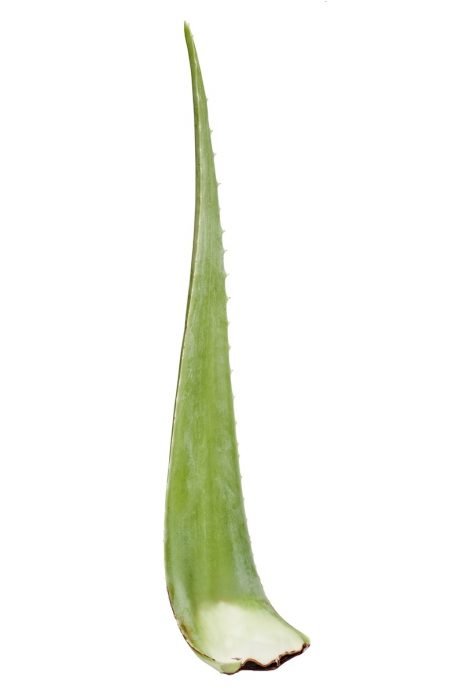
Aloe vera does not have a stem as such, so only a leaf with a base can be rooted separately.
Growing from seeds
In principle, aloe can be grown from seed, but it is a long and painstaking process.
- Prepare the soil: 1 part of leafy land (peat), 2 parts of turf land, 2 parts of river sand.
- We sow seeds in early spring. You can lightly sprinkle them with earth or simply press into the soil.
- We carefully monitor the sowing, the sand should always be wet. The optimum germination temperature is 20 ºC.
- When the first shoots appear, you need to transfer the plant to a bright window or illuminate it with a fluorescent lamp.
- In the phase of 2-3 leaves we dive into separate pots.
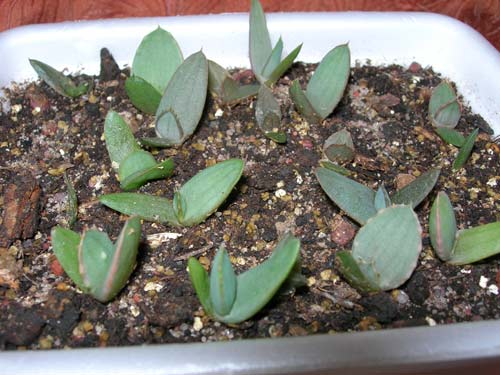
Aloe seedlings ready for picking
Care rules on which flowering at home depends
The homemade aloe flower differs significantly from its naturally grown counterpart in an abundance of sunlight.
Young indoor aloe flowers, even under the best conditions and care, are not able to bloom. A succulent plant produces flowers when it reaches maturity, often after 10 years, so few people know how aloe blooms. To see its shoots, you need to carefully plan the care and choose the flowering period. The winter season is best suited for this purpose.
Even inexperienced growers know how often aloe blooms and that there are several factors to consider when planning. Nuances that play a role in the flowering of aloe:
Nuances that play a role in the flowering of aloe:
- temperature
- watering
- feeding
- pest control
Temperature
During flowering, the temperature of the room in which the agave is kept can be raised by 10 ° C.
For high-quality flowering, you can install additional lighting in the room to increase the length of the day. The air in the room should not be humid, so that decay of the root system does not begin.

Watering
Watering the flower with water is often not recommended, 1-2 times a week is enough. Aloe retains moisture in the leaves, so it can be kept in conditions of relatively low humidity for a long time. From abundant watering, the root system of the plant can rot. In this case, the leaves of the agave become swollen and watery. The only way to save the flower is to remove part of the plant.
In the summer, the succulent is watered when the soil in the pot is almost 15% dry. By the end of the hot season, watering is gradually reduced, reducing the dose of water
At this point, it is important to control the moisture in the soil. For irrigation, water is taken on 5-8 degrees above room temperature
The procedure goes as follows:
- High-quality drainage is done in the lower part of the pot.
- A special tray is prepared, which is filled with water.
- A pot with a flower is placed in the pallet and remains intact for 30-40 minutes.
- After the roots are saturated with moisture through the drainage, the water is drained.
The centenarian will tell you how much water he needs. Between watering procedures, it is enough to regularly spray it from a spray bottle and wipe the leaves.

Top dressing
You can feed the flower with mineral fertilizers, which are sold in flower shops for cacti or succulents. You need to choose a warm season for fertilizing the soil, for example, spring or summer. At this moment, the flower will actively absorb all useful substances from the soil.
Diseases and pests
If feeding the plant is correct, as well as watering, then the succulent will not hurt. The centenary is not a very attractive plant for pests, but pests such as mealybugs, spider mites or thrips can attack it. To get rid of parasites that destroy the root system and leaf plates, it is enough to rinse the flower and transplant it into new nutrient soil.
If the succulent is heavily infested, the following insecticides can be used:
- "Aktara"
- "Confidor"
- "Actellik"
- "Akarin"
Means "Aktellik" and "Akarin" are used mainly for the destruction of spider mites.

Other rules
A number of recommendations to help speed up the flowering process and prolong the life of the plant:
- With the onset of the hot season, you can take the pot of aloe out into the yard so that it is saturated with natural sunlight. In this case, you can not put aloe under direct rays. It is best to cover the plant under a canopy. At this time, the leaves may acquire a strange purple hue, but over time it will go away, leaving room for the familiar green.
- With the onset of cold weather, the flower must be returned to the house and left in a specially prepared room. It is best if it is a well-lit room on the south side of the house. You should not place the succulent in front of a door or window if it is just transplanted into a new pot.
- In cold weather, watering aloe can be reduced to 2-3 times a month.
- Top dressing is done in early autumn, spring and summer no more than once a month. For fertilization, it is enough to mix the soil for succulents and cacti.

Blooming aloe species
The family of this type of flowers has, according to various sources, from 260 to 500 species, almost all of which can bloom. However, in the natural environment, such a phenomenon can be seen extremely rarely, as they say - once every 100 years. Thanks to this myth, aloe has received a different name among the people - agave.
Aloe flowers boast bright and varied colors. There are shades such as:
- White;
- Red;
- Orange;
- yellow.
On a succulent, there can be either one flowering arrow or several.It contains a large number of small flowers, decorated in a brush. Inflorescences open gradually starting from the bottom.
It should be noted that when flowering at home, aloe seeds are not collected, since they do not have time to ripen to a suitable state.

The most common types of aloe growing at home are:
- aloe vera;
- tree-like;
- variegated.
Aloe vera has fleshy stems that form a rosette. The leaves themselves are covered with white spots and have thorns on the lateral areas. Its tassel-like inflorescences come in a rather faded orange hue.

The tree type is distinguished by its high growth rate and healing properties. Its leaves are also collected in the form of a rosette, in color it is a mixture of gray and green. Inflorescences delight with their palette, which has at least 4 shades:
- Red;
- yellow;
- pink;
- scarlet.
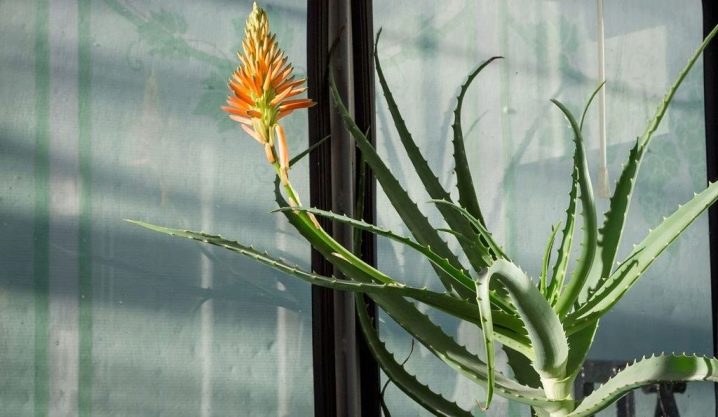
The variegated aloe has a green and white brindle color. Maximum leaf height - 30 cm... This look looks great with any decor, therefore it is in demand among flower growers. It also rarely blooms pink or yellow.
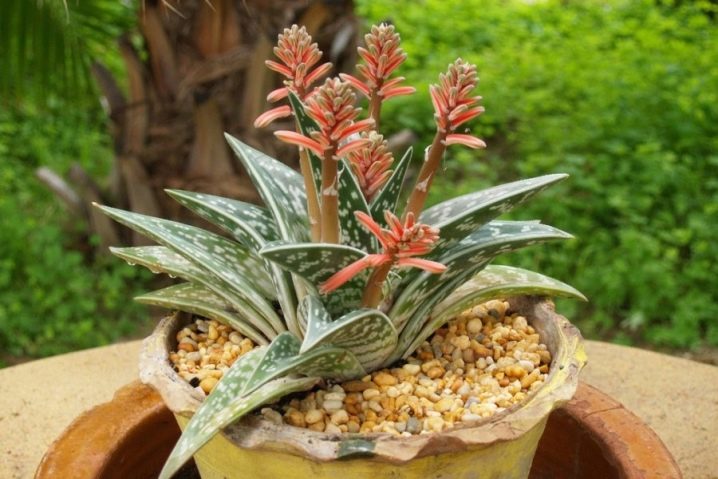
What will happen when the petals fall?
The seeds are very numerous and have a grayish-black color.
At home, it is extremely difficult to achieve flowering. It is necessary to create a real Africa for him. If the plant still pleases with flowering, it is imperative to help it recuperate after the end of the wonderful period. Are there any signs associated with the flowering of the plant, why does the agave bloom in the house? They say that if buds appear on aloe, it means that an angel has settled in it, as many petals as there are happy years ahead.
If you find an error, please select a piece of text and press Ctrl + Enter.
1 Types of homemade aloe
In total, there are about 500 varieties of aloe, including wild and hybrid plants. In the wild, aloe is a shrub plant that grows 6 to 8 meters in height. Despite the fact that initially aloe grew in hot, dry climates, succulent grows well at home. Most often, in apartments and houses, you can see herbaceous specimens of a much more modest size than their wild relatives. There are other varieties of this houseplant.
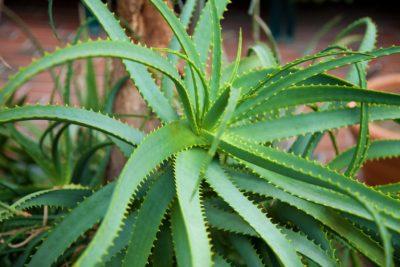
Aloe is a short trunk or stem that produces thick, xiphoid leaves that are collected in rosettes and arranged in a spiral. The length of the leaves of some species reaches 60 cm. The leaves can be smooth or covered with thorns and cilia, depending on the variety. The pulp of the leaves is divided by cells, which retain moisture during prolonged drought. During flowering, a long arrow is released from the rosette of leaves, at the end of which is a spike-shaped flower with tubular petals. The color of the petals is white, purple, yellow or orange.
| Variety name | Description |
|---|---|
| Aloe tree (agave) | The most common indoor aloe with abundant green mass. The leaves are sword-shaped, green, the surface is velvety, along the edges there are soft thorns. The length of the leaves is about 30 cm.The height of the agave sometimes reaches 1 m.With proper care, the plant lives for about 20 years |
| Aloe real (Aloe vera) | Used in the culinary and cosmetic industry. It grows in the form of lush rosettes, the trunk of the plant is weakly expressed. Leaves are grayish-green, the surface is slightly corrugated |
| Aloe tiger (variegated) | The plant is valued for its original appearance, and is more often used as a decorative plant. Height up to 30 cm, leaves are wide, triangular, dark green with white transverse stripes. In summer, it can bloom with yellow, red or pink inflorescences |
| Aloe awesome | A large plant with thick, fleshy leaves. The surface of the leaves is covered with numerous strong red-brown spines.Despite the unpleasant appearance, the juice of this flower is actively used in pharmacology and cosmetology. |
| Aloe soap | Nice looking flower. The wide leaves form a rosette, which in turn is attached to a small, sturdy stem. The leaves are dark green in color with numerous white spots, brownish thorns are located along the edges. Blooms in yellow, orange, red and pink flowers |
| Aloe spinous | Miniature bushy plant. The leaves are connected in a large basal rosette, gray-green with white blotches, along the edges there is a white jagged border, at the end forming an awn. It blooms with orange-red tubular flowers |
Periodicity and timing of flowering
The generally accepted concepts of the frequency of flowering of aloe with an interval of 2 decades are fairly approximate. With proper care, the plant at home can bloom more often. As a rule, a single flower appears in the axils of the upper leaves. Aloe inflorescences have a fairly large amount of nectar, which spreads a strong scent... Therefore, allergy sufferers should be careful with it.
It is necessary to remember about the peculiarities of the development of this plant. For the first three years it has been growing very actively. This period is characterized by the absence of the need for wintering.
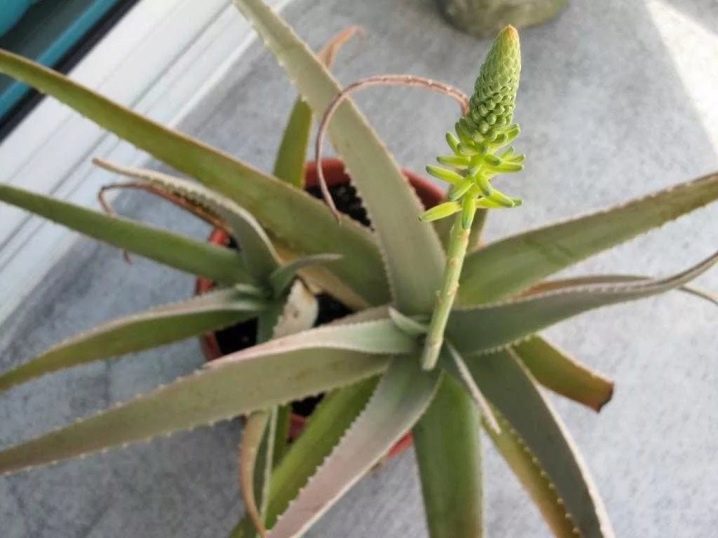
The period of winter dormancy for the plant is created artificially. To do this, the flower is placed in a cool place and watered much less frequently. In this case, the earth should be semi-dry. Such conditions will be organized in the fall. It is advisable to transplant the aloe into a large container before that. The best time for the procedure is spring. So, before wintering, the plant will have time to adapt to a new place and soil.
After carrying out these manipulations, special conditions are created for flowering. At the same time, it is not recommended to move and turn the flower pot, as well as fill it with water.
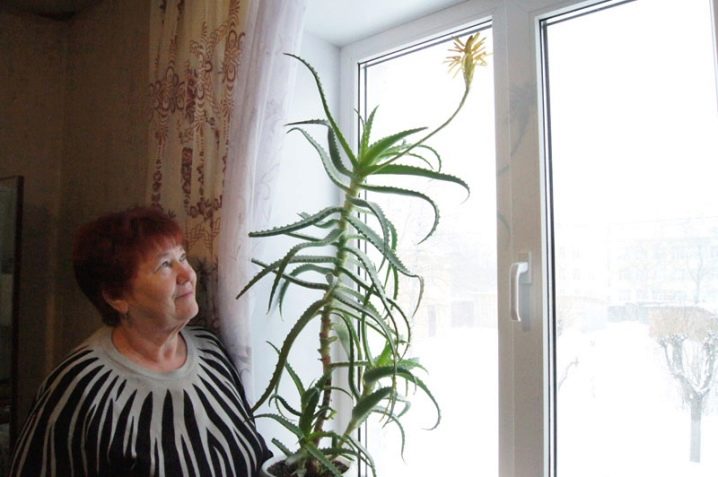
What does a flowering plant look like?
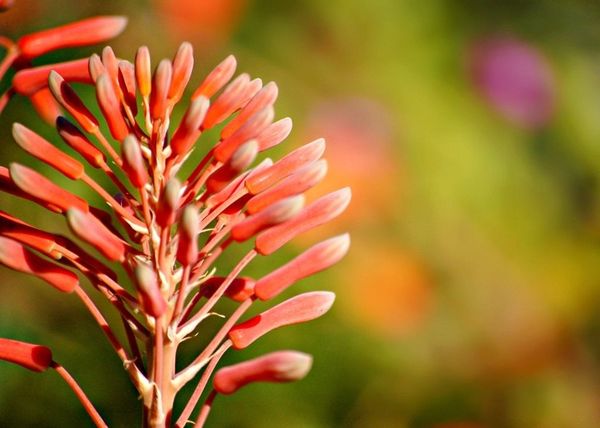
So, the question of whether aloe blooms at home cannot be answered unequivocally. Like all succulents, this plant is capable of blooming in indoor conditions, but not all growers manage to introduce a desert inhabitant into the flowering phase.
Before we figure out what can cause this culture to form a bud on your windowsill, let's find out what a blooming aloe flower looks like.
From a decorative point of view, the flowering of this plant is of little interest. An arrow fired will indicate that your home aloe has entered its proper phase. Length peduncle can reach up to half a meter. After a while, at the very top, a kind of panicle is formed from the buds of future flowers.
The flowers will bloom in turn: when the lower ones begin to fade, the upper ones will begin to bloom. The aloe flower is small, like a bell. The color of the petals depends on the variety - it is yellow, orange and even red. Due to the elongated and narrow bells hanging down, the peduncle will look like a candle.
Aloe flowers have a very strong scent. For this reason, you should not bring this plant to the flowering phase for people who suffer from allergies.
How aloe blooms, you now know. It's time to talk about when this can happen, and under what conditions.
What kind of aloe grows on your windowsill?
Indoor plant, modest in size, "in the wild" grows up to 3 meters or more. In the vastness of Africa, thickets of aloe resemble a bizarre forest. And often this succulent in nature is decorated with bright long candle flowers of scarlet, yellowish or orange color.
In total, there are about 350 species of aloe, not all well understood. Basically, houses are grown "just aloe", not trying to find out its exact classification and name. Moreover, many species are similar in appearance.
Aloe vera or tree-like aloe (Aloe arborescens) is most commonly found as a house plant. Both species bloom, their flowering is distinguished by the length of the flowering arrow, the color of the flowers and the duration of the period.
Exotic lovers have a terrifying aloe (Aloe ferox). The species is named so because of its red-orange sharp spines. On a powerful trunk, a rosette of leaves is located closer to the crown. The peduncle of this aloe has 5-12 brushes of fragrant flowers.
How to make aloe bloom? We'll have to work hard and create conditions close to natural.
Blossoming tree aloe (Aloe arborescens). plantsystematics Aloe vera bloom. WoS Aloe ferox bloom. Desert Plants of Avalon
When is aloe able to bloom?
The plant belongs to succulents, unpretentious to living conditions, perfectly tolerates prolonged drought. You can safely leave it for 2-3 weeks without worry, leaving on vacation.
Under natural conditions, aloe is exposed to significant temperature changes, experiencing periods of rest and increased activity. It is these changes that the pampered houseplant lacks.
Most often, a flower pot with a succulent plant stands in a room where a comfortable temperature is maintained within 22-25 degrees, water it along with the rest of the plants. In such conditions, flowering cannot be expected.
To awaken the craving for the formation of a peduncle, it is required to artificially create a dormant period for aloe, after which a new life cycle will begin. The winter months are best suited for this.
Aloe must be over 5 years old to bloom. And ideally, you need to have a plant that has already passed the ten-year mark. In the first 3 years of the life of the succulent, leaves and roots are actively formed, therefore, it is impossible to achieve neither medicinal properties nor flowers from aloe at this time.
Signs associated with a house plant
Signs and superstitions about aloe in the house have a positive meaning. It is believed that this flower is able to have a positive effect on all family members, to attract happiness. To do this, you just need to know about the features of the plant and perform simple rituals.
Symbol of faith and love
This magical plant is capable of attracting love. To achieve happiness in your personal life, the following steps are performed:
- Tear off 13 petals from the flower.
- Mentally, without saying anything aloud, they ask the plant for forgiveness.
- The leaves are placed in a dark place for 12 days.
- On day 13, the dried leaves are burned.
- The ash remaining after performing these actions is scattered near the threshold.
Wellness
If problems often arise in the family, people are constantly sick, this indicates a weak biofield of the space at home.
Even in ancient times, the plant was used to eliminate pain and heal wounds. To achieve a speedy recovery, the leaves of the flower were dried and placed in a bag. It was hung as a talisman on a person suffering from an illness.
Also, women used the sap of the plant to rejuvenate the skin. Even now, gels are made on its basis that perform this task.
Why is it blooming
Aloe blooms extremely rarely. If he released an arrow, on the top of which numerous small flowers flaunt, this is a good omen. This means that happiness and harmony reign in the house, it is under the protection of higher powers.
Also, according to legends, flowering indicates that a guardian angel has settled in the dwelling. To understand how many years of happiness he will give the family, you just need to count the number of petals that have appeared.
For a blooming perennial, it is extremely important to find the right place. For example, if you put it on the eastern windowsill, you will be able to achieve the following results:
- financial well-being;
- improve family relationships;
- avoid quarrels, conflicts.
If you place a pot with a flowering plant in the south, you can find true love and build relationships with all those close to you.
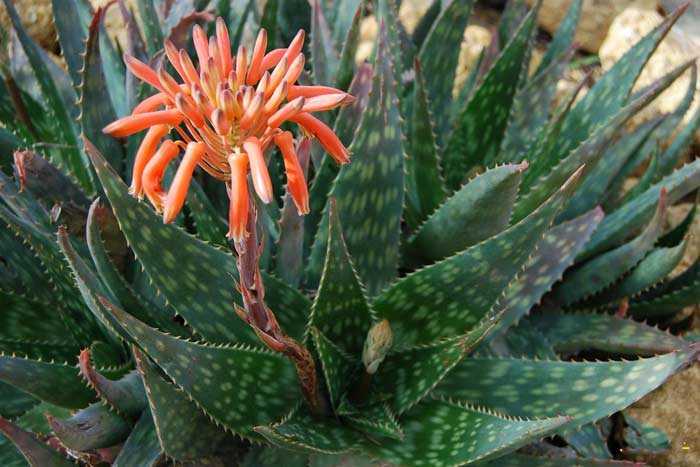
Why does it start to turn yellow
If the perennial care is correct, but despite this, the plates begin to dry and turn yellow, you need to be wary. It is possible that the family amulet took on all the negativity that was directed at the inhabitants of the house.The concentration of negative energy is so great that one flower is not able to cope with it.
It is recommended to purchase several aloe vases and place them in different rooms. In addition, you need to find out where the danger to the family comes from and to neutralize it in a timely manner.

